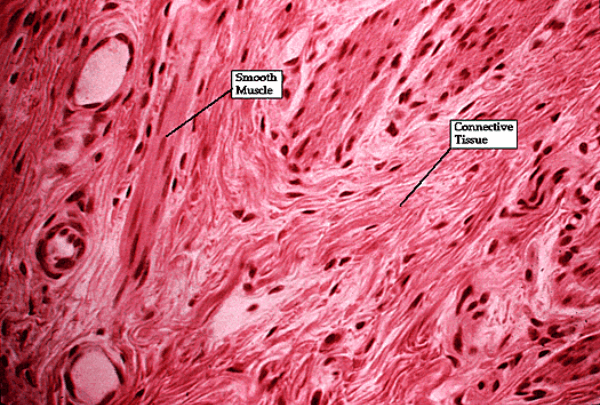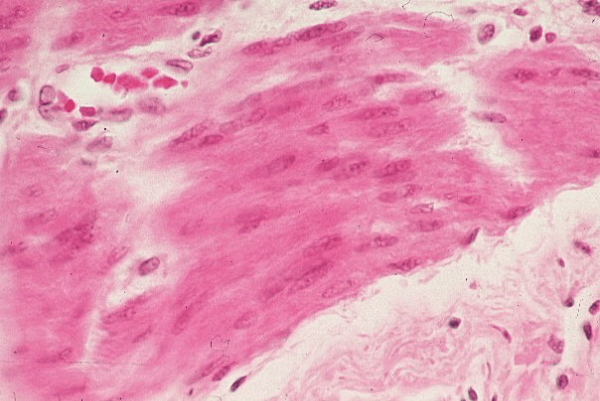Biology Forum › Physiology › Smooth muscle vs dense regular connective tissue
- AuthorPosts
- August 10, 2021 at 12:52 am #118460
 Josie-Ann Le BlancParticipant
Josie-Ann Le BlancParticipantSmooth muscle tissue vs dense regular connective tissue
What are tissues?
When cells of an organism with similar functions and structures come together to form a group, this unit is called tissue. The study of tissues is called histology and so a scientist who studies tissues is a histologist.
Tissue types that share similarities can come together to form organs. Within living things, there are numerous tissue types. In humans, the four main tissue types are epithelial, connective, muscle and nervous tissue. Nervous tissue transports signals and “messages” around the body and epithelial tissue protects and lines the bodily passages.
The tissue that holds other tissues together and supports them is connective tissue. Muscle tissue assists with the movement of the skeleton and surrounds other important organs.

Figure 1: The four types of tissues present in the human body.
SourceFun fact: The most abundant tissue type in the human body is skeletal muscle.
Connective and Muscular Tissue
As the name implies, connective tissues connect the different cells and tissues of the body to each other. There are different types of connective tissues which each contain its own matrix. These include blood, bone, cartilage, adipose, elastic and fibrous tissues. They provide physical support to the body, create pathways for nerve and blood vessels, assist with immune activity and exchange between capillaries and active cells.
Muscular tissue works through the direction and coordination of the cells to create an effective contraction, This plays a vital role in almost all major movements that the body makes. The types of muscle tissues are skeletal, smooth and cardiac.
Cardiac muscle is only found in the heart and needs to have incredible strength and endurance since the heart never stops beating.
How does connective tissue differ from muscle tissue?
How does connective tissue differ from muscle tissues? Well, both connective and muscle tissue originate from the same source, the mesoderm, which is the third germ layer. This is why they are often associated with each other. However, despite their similar backgrounds, muscle and connective tissues are different. Connective tissues have a matrix, a network of non-living intracellular material that is not present in muscle tissue. Hence, the primary function of the muscle tissue is to aid with bodily movements whereas the connective tissue provides a strong link and passage between tissues, organs and the rest of the body.
Guess some parts of the body that may contain both muscle and connective tissues.
Smooth Muscle vs Dense Regular Connective Tissue

Figure 2: The border of Smooth Muscle and dense regular connective tissue.
SourceSmooth muscle is a type of muscular tissue that has a single nucleus present in each cell and is a spindle-shaped fiber. The name “smooth” muscle comes from the absence of striations in these tissues which are typical for muscle tissue. They can be found in walls of organs that are “hollow” such as the urinary bladder, uterus and stomach as well as lining passageways like the tracts of the urinary and reproductive systems as well as circulatory system arteries and veins.
The dense connective tissue contains a lot of collagen fibers and so is more resistant to stretching. Dense regular connective tissue has fibers that are parallel to one another. This positioning enhances the tensile strength of tissue and makes it quite resistant to stretching in the direction in which the fibers are oriented. What is an example of dense regular connective tissue? A few body parts that are made of dense regular connective tissue are ligaments and tendons.
Often the appearance of tissues can look very similar up close and so it is easy to confuse them. Dense muscle can easily be mistaken for smooth connective tissue, in figure 3 below we can clearly see why. Simple distinguishable traits are that smooth muscle has nuclei that do not stain as strongly and they tend to be larger. Connective tissue fibers also are more loosely packed than smooth muscle fibers.

Figure 3: Smooth muscle vs connective tissue
SourceGo back to Figure 2 and see if you can correctly guess which one is smooth muscle and which is connective tissue. Comment your answer below!
To learn more about tissues, go to the Biology-Online Dictionary and read up on tissues.
- August 23, 2021 at 10:48 pm #119154
 victoriamackenzieParticipant
victoriamackenzieParticipantHi, great informative article, thanks!
- August 23, 2021 at 10:57 pm #119167
 Josie-Ann Le BlancParticipant
Josie-Ann Le BlancParticipantHappy to help!
- September 15, 2021 at 10:20 pm #119233
 Karl peterParticipant
Karl peterParticipantIts really very informative for me specially
Smooth muscle is a type of muscular tissue that has a single nucleus present in each cell and is a spindle-shaped fiber. The name “smooth” muscle comes from the absence of striations in these tissues which are typical for muscle tissue. They can be found in walls of organs that are “hollow” such as the urinary bladder, uterus and stomach as well as lining passageways like the tracts of the urinary and reproductive systems as well as circulatory system arteries and veins.
this information
I have amazing site for physical exercise
[url=https://www.doihealthy.com]My Health Calculator[=/url]
- AuthorPosts
You must be logged in to reply to this topic.

